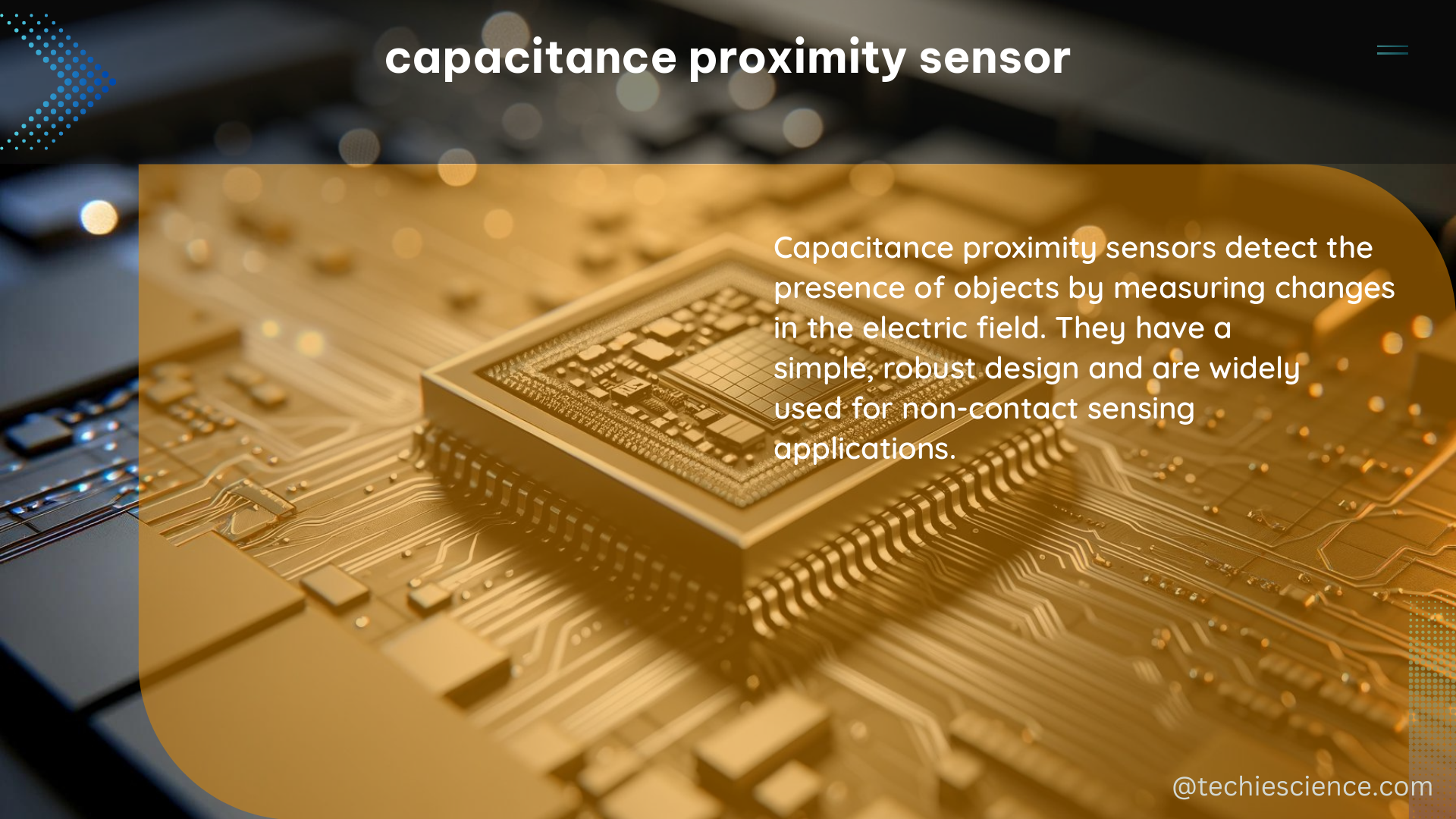Capacitance proximity sensors are versatile and accurate devices that can detect the presence or absence of an object by using a change in capacitance. These sensors operate as a simple capacitor, with the sensing face electrically connected to an internal oscillator circuit and the target object forming part of the feedback capacitance. When the object approaches the sensor, the oscillations increase until the set threshold level is reached, activating the output.
Understanding the Principles of Capacitance Proximity Sensors
Capacitance proximity sensors work on the principle of capacitive sensing, where the sensor’s capacitance changes when an object enters its sensing range. This change in capacitance is measured and used to determine the presence and distance of the object.
One common implementation is the coplanar capacitive proximity sensor, which consists of a pair of electrically conductive electrodes. A potential difference is applied between these electrodes, generating an electric field. When a grounded object enters the sensing range, it adds capacitance to the oscillator circuit, causing a shift in the oscillation frequency. This frequency shift can be measured and used to detect the object’s presence and proximity.
Technical Specifications of Capacitance Proximity Sensors

Capacitance proximity sensors have a wide range of technical specifications, depending on the specific application and design. Here are some key specifications to consider:
-
Sensing Range: Capacitance proximity sensors can typically detect objects within a range of 1-10 mm, with some advanced sensors capable of sensing up to 50 mm or more.
-
Sensitivity: The sensitivity of a capacitance proximity sensor is often expressed in terms of the minimum detectable change in capacitance, which can be as low as 0.1 mm.
-
Noise Immunity: High-quality capacitance proximity sensors can have a noise immunity of up to 20 kV/m, making them resistant to electromagnetic interference.
-
Response Time: The response time of a capacitance proximity sensor can be as fast as 10 μs, allowing for rapid detection of objects.
-
Power Consumption: Capacitance proximity sensors can have a low power consumption, often less than 1 mW, making them suitable for battery-powered applications.
-
Temperature Range: Capacitance proximity sensors can operate over a wide temperature range, typically from -40°C to +85°C.
Implementing Capacitance Proximity Sensors in DIY Projects
For DIY enthusiasts, there are several options for incorporating capacitance proximity sensors into their projects. One example is the 3D-Printed Capacitive Sensor Objects for Object Recognition Assays, which uses a Bare Conductive touch board based on an Arduino Leonardo microcontroller and the MPR121 capacitive touch/proximity sensing chip.
The touch board has twelve capacitive touch/proximity sensing electrodes that can be programmed using the Arduino IDE. By modifying the open-source code, the touch/proximity electrodes can be used to detect the presence or absence of an object and send a TTL pulse to a Noldus IO Box, which can be recorded by the Ethovision analysis software.
Advanced Capacitance Proximity Sensor Techniques
Capacitance proximity sensors can be further enhanced through the use of advanced techniques, such as active shielding. Active shielding involves the use of an additional electrode that is driven with a signal that is 180 degrees out of phase with the sensing electrode. This helps to reduce the effects of parasitic capacitances and improve the sensor’s sensitivity and noise immunity.
Another advanced technique is the use of dual-plate capacitive proximity sensors, which employ two parallel plates to create a more uniform electric field. This design can provide a higher sensing range and better linearity compared to single-plate sensors.
Practical Applications of Capacitance Proximity Sensors
Capacitance proximity sensors find a wide range of applications in various industries, including:
-
Industrial Automation: Capacitance proximity sensors are used for object detection, position sensing, and material identification in industrial automation systems.
-
Robotics and Automation: These sensors are used for proximity detection, collision avoidance, and object manipulation in robotic systems.
-
Smart Home and IoT: Capacitance proximity sensors are used for touch-based user interfaces, gesture recognition, and presence detection in smart home and IoT devices.
-
Automotive: Capacitance proximity sensors are used for applications such as door handle detection, seat occupancy sensing, and gesture control in vehicles.
-
Medical and Healthcare: These sensors are used for patient monitoring, medical equipment positioning, and assistive technology applications.
-
Environmental Monitoring: Capacitance proximity sensors can be used for water level monitoring, soil moisture detection, and other environmental sensing applications.
Conclusion
Capacitance proximity sensors are powerful and versatile devices that offer a range of advantages, including high sensitivity, long sensing range, and immunity to electromagnetic interference. With their growing applications in various industries and the availability of DIY-friendly solutions, capacitance proximity sensors are becoming increasingly accessible and valuable for both professionals and hobbyists alike.
References
- Design and printing of a coplanar capacitive proximity sensor to identify recyclable materials, ScienceDirect, 2022.
- Application of Capacitance Proximity Sensor for the Identification of Paper and Plastic from Recycling Materials, ResearchGate, 2017.
- Recent Advances on Capacitive Proximity Sensors, MDPI, 2022.
- 3D-Printed Capacitive Sensor Objects for Object Recognition Assays, NCBI, 2021.
- Capacitive Sensing: Ins and Outs of Active Shielding, Texas Instruments, 2022.

The lambdageeks.com Core SME Team is a group of experienced subject matter experts from diverse scientific and technical fields including Physics, Chemistry, Technology,Electronics & Electrical Engineering, Automotive, Mechanical Engineering. Our team collaborates to create high-quality, well-researched articles on a wide range of science and technology topics for the lambdageeks.com website.
All Our Senior SME are having more than 7 Years of experience in the respective fields . They are either Working Industry Professionals or assocaited With different Universities. Refer Our Authors Page to get to know About our Core SMEs.